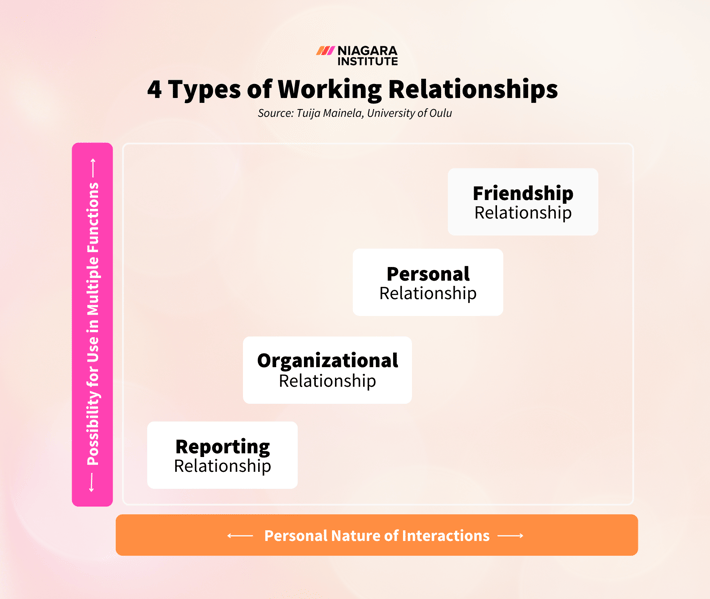5 min read
The Importance of Good Professional Relationships at Work
13 years and two months. That’s the amount of time the average person spends at work in their lifetime, according to HuffPost. Add a year and two...
.png)
From the supervisor who has become your mentor to your teammate whose camaraderie lightens the burdens of the daily grind or the grumpy colleague that you struggle to get along with, our working relationships influence our experience at work for better or worse.
For this reason, it’s important to understand what type of working relationship you have with those around you so that you can make an intentional effort to strengthen or improve those relationships. First, though, familiarize yourself with the 4 main types of working relationships - reporting, organizational, personal, and friendship.
A working relationship refers to the professional connections you make with people in the workplace, such as your boss, teammates, colleagues, and clients. These relationships are typically established to achieve specific goals, complete tasks, or fulfill job responsibilities. However, given that the average person will spend over a third of their life (90,000+ hours) at work, it should come as no surprise that some relationships go beyond the office walls and evolve into meaningful personal friendships.
Granted, not all working relationships are created equal. In fact, according to research conducted by Tuija Mainela, a Professor at the University of Oulu, there are 4 main types of working relationships:

As you review the definition and characteristics of each below, it will become clear that the four types of working relationships are not mutually exclusive. They can, and often do, overlap in various ways depending on the situation and organization. For example, it is entirely possible to have both a reporting and friendship relationship with the same person.
Reporting relationships are formal and hierarchical in nature. As the name suggests, one person typically reports to the other person. Think of a boss and their employee. In this type of working relationship, there is a clear chain of command, and one person has a higher level of authority than the other. While there is a power imbalance in this type of working relationship, it is intentional as it helps ensure work is completed, tasks are delegated, goals are met, and problems are dealt with.
Taylor is a manager who supervises a small team in the finance department of an organization. Each employee reports to Taylor, who is responsible for assigning their tasks, giving them feedback, evaluating their performance, and ensuring that the team meets its objectives. While Taylor engages in polite small talk, they maintain a level of professionalism in every encounter and keep a distance from the personal lives of their employees.
Organizational relationships are formal in nature and serve to support the operations of the organization. They encompass your connections to people in other teams, departments, or divisions. In other words, these relationships are based on the structure of the organization. Think of a relationship between someone in human resources and purchasing. They don’t work together often, but when they do, they do so because they have a common goal. Organizational relationships often involve collaboration, coordination, and communication between various teams or functions to ensure the overall success and functioning of the organization.
In a large technology company, Bailey works in the software development department, while Parker works in the quality assurance (QA) department. Bailey and Parker have an organizational relationship, which means they work together occasionally to ensure that new software is developed, tested, and delivered effectively. This requires them to collaborate, communicate, and coordinate with each other in order to achieve their common mandate. However, they are not the person the other would go to for help, support with a problem, or discuss personal details with in any depth.
Personal relationships are somewhat formal in nature; however, they involve a greater degree of personal connection than the previous types of work relationships. When you have a personal relationship with someone, you don’t interact with them because you have to for work, but because you want to. You want their opinion, advice, guidance, or support. You share a common language and understanding that goes beyond your organizational roles. When intentionally nurtured, these types of relationships make your overall work experience better.
Alex works in sales. Aiden works in marketing. While their jobs require them to work together occasionally, they are closer than others in the same positions. They have lunch together, share personal stories, and provide emotional support or advice when encountering a problem at work. Their personal relationship adds a friendly and supportive dimension to their professional interactions, enhancing their overall job satisfaction.
Friendship relationships are the least formal in nature of the four main types of working relationships. They are deeper, more personal connections that are characterized by mutual trust, shared interests, and a genuine liking for one another. Friendship relationships often extend beyond the workplace, as individuals choose to socialize with one another outside of work hours. Think of a coworker you would want to invite to grab drinks with after work.
Interestingly, in a 2022 Gallup study, it was found that people who have a best friend at work are significantly more likely to engage customers/internal partners, get more done in less time, contribute to a safer workplace (fewer accidents and reliability concerns), innovate and share ideas, and have fun while at work. Unfortunately, only 2 in 10 U.S. respondents reported actually having a best friend at work.
Mica and Emery have worked together at different organizations over the past decade. During that time, they have built and maintained a close friendship due to their shared experiences and common interests. While they maintain professionalism in their current workplace, they often meet outside work for lunch or a hike. They deeply value their relationship as it allows them to be each other’s confidantes and sounding boards whenever they experience a problem or conflict in their personal or professional life.
.png)
5 min read
13 years and two months. That’s the amount of time the average person spends at work in their lifetime, according to HuffPost. Add a year and two...
.png)
5 min read
Colleagues can easily be some of the people you spend the most time with. After all, how many other people do you interact with as regularly as you...

7 min read
A happy and engaged team is the backbone of any successful organization.